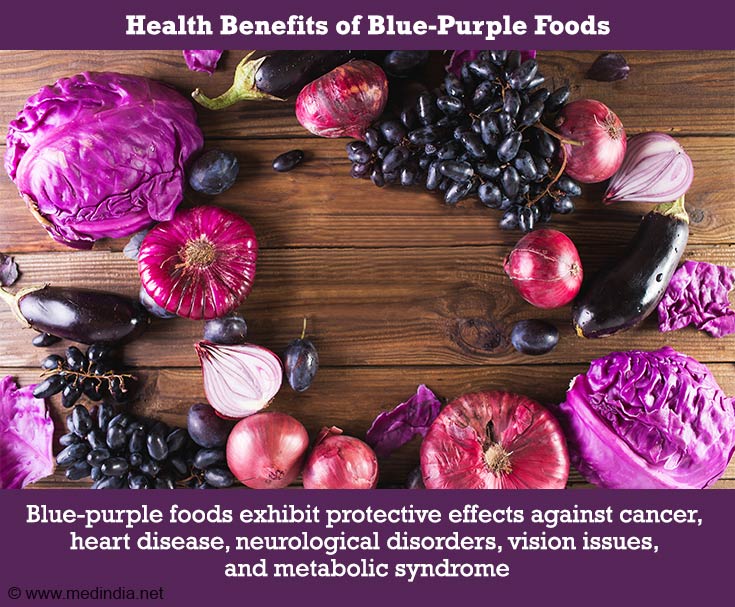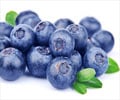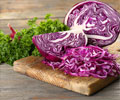- Natural Purple foods offer Numerous Health Benefits - (https://medicaljournalshouse.com/index.php/JDrug-Discovery-Development/article/view/51)
- Should We 'Eat a Rainbow'? An Umbrella Review of the Health Effects of Colorful Bioactive Pigments in Fruits and Vegetables - (https://www.mdpi.com/1420-3049/27/13/4061)
- Health Benefits of Anthocyanins and Their Encapsulation for Potential Use in Food Systems: A Review - (https://pubmed.ncbi.nlm.nih.gov/25745811/)
- Purple Wheat: Food Development, Anthocyanin Stability, and Potential Health Benefits - (https://www.mdpi.com/2304-8158/12/7/1358)
- Anthocyanidins and anthocyanins: colored pigments as food, pharmaceutical ingredients, and the potential health benefits - (https://foodandnutritionresearch.net/index.php/fnr/article/view/1257)
- A Review of the Science of Colorful, Plant-Based Food and Practical Strategies for "Eating the Rainbow" - (https://www.hindawi.com/journals/jnme/2019/2125070/)
- Anthocyanins in Whole Grain Cereals and Their Potential Effect on Health - (https://www.mdpi.com/2072-6643/12/10/2922)
- Dietary Effects of Anthocyanins in Human Health: A Comprehensive Review - (https://www.mdpi.com/1424-8247/14/7/690)
- Enhanced task-related brain activation and resting perfusion in healthy older adults after chronic blueberry supplementation - (https://pubmed.ncbi.nlm.nih.gov/28249119/)
- Grown to Be Blue-Antioxidant Properties and Health Effects of Colored Vegetables. Part II: Leafy, Fruit, and Other Vegetables - (https://www.mdpi.com/2076-3921/9/2/97)
- Red cabbage soup - (https://greenbowl2soul.com/red-cabbage-soup/#recipe)
- Blackberry Smoothie Recipe (No Banana) - (https://www.platingsandpairings.com/blackberry-smoothie-recipe-no-banana/)
- Carrot Hummus - (https://wavesinthekitchen.com/carrot-hummus/)
What are Blue-Purple Foods?
Blue-purple foods have gained great significance for their powerful antioxidant activities that protect against diseases. The different colors in foods are contributed by different phytonutrients that are essential for good health. The purple and blue foods are colored by phytopigments called anthocyanins(1✔ ✔Trusted Source
Natural Purple foods offer Numerous Health Benefits
Go to source).
Several pieces of evidence highlight the benefits of eating the rainbow colors. The background of its potential health benefits arises from the presence of pigmented phytonutrients or bioactive pigments that give the foods such vibrant colors. This may include lycopene in red foods, alpha-carotene in yellow foods, beta-carotene in orange foods, chlorophyll in green foods, and flavones in white foods. Every phytonutrient creates an affirmative influence on health, and eating different colors of fruits and vegetables delivers all-around health benefits(2✔ ✔Trusted Source
Should We 'Eat a Rainbow'? An Umbrella Review of the Health Effects of Colorful Bioactive Pigments in Fruits and Vegetables
Go to source).
All About Anthocyanins
Anthocyanins belong to the widespread group of plant constituents called flavonoids. The presence of anthocyanins strokes the foods with bright blue, purple, and red colors. Several vegetables, fruits, flowers, and even cereals are known to possess anthocyanins. Along with their coloring nature, they have gained great attention for their health-benefiting actions. Acting as antioxidants, anthocyanins or blue-purple foods help prevent cardiovascular diseases, diabetes, neuronal diseases, cancer, inflammation, and many more(2✔ ✔Trusted Source
Should We 'Eat a Rainbow'? An Umbrella Review of the Health Effects of Colorful Bioactive Pigments in Fruits and Vegetables
Go to source).
Anthocyanins are the star players in blue-purple foods. They are known to exhibit a purple hue at a neutral pH and change to blue at an alkaline pH. Having an attractive hue, it is used as a colorant and additive in beverages and foods. The pigment is generally extracted from flowers, fruits, and vegetables. It is a popular food additive used in the production of purple-colored jam, confectioneries, and yogurt drinks. However, the phytonutrient’s stability depends on several factors; hence, stabilization methods have to be installed to minimize its loss during processing(4✔ ✔Trusted Source
Purple Wheat: Food Development, Anthocyanin Stability, and Potential Health Benefits
Go to source, 5✔ ✔Trusted Source
Anthocyanidins and anthocyanins: colored pigments as food, pharmaceutical ingredients, and the potential health benefits
Go to source).
It also plays a significant role in traditional medicine and nutraceuticals. Traditionally, anthocyanins are used as appetite stimulants, chlorogenic agents, and for the treatment of many diseases. Anthocyanins aid in reducing the risk of diseases through indirect and direct pathways. The indirect pathway includes apoptosis by reducing oxidative stress, lipid peroxidation, and downregulation of cell proliferation. Through the direct pathway, the phytonutrient scavenges free radicals,exhibiting antioxidant properties, thereby curtailing the risk of chronic diseases(5✔ ✔Trusted Source
Anthocyanidins and anthocyanins: colored pigments as food, pharmaceutical ingredients, and the potential health benefits
Go to source).
List of Blue-Purple Foods
There are several blue- and purple-colored fruits and vegetables grown and available for human consumption. Some of the blue-purple fruits include -
- Blueberries
- Mulberries
- Acai berries
- Blackberries
- Blackcurrants
- Grapes
- Boysenberries
- Figs
- Prunes
- Raisins
Vegetables that act as a great dietary source of anthocyanin are listed below -
- Purple carrot
- Purple cabbage
- Purple cauliflower
- Purple kale
- Purple bell peppers
- Purple beetroot
- Purple asparagus
- Eggplant
- Purple sweet potato
- Purple corn
- Purple starfruit(1✔ ✔Trusted Source
Natural Purple foods offer Numerous Health Benefits
Go to source, 3✔ ✔Trusted Source
Health Benefits of Anthocyanins and Their Encapsulation for Potential Use in Food Systems: A Review
Go to source, 6✔ ✔Trusted Source
A Review of the Science of Colorful, Plant-Based Food and Practical Strategies for "Eating the Rainbow"
Go to source) - Onion
- Broccoli
- Cereals like black rice
- Dark chocolate
Pigmented grains like rice, maize, barley, and wheat have recently received great interest in the food industry for their health-attributing attributes(4✔ ✔Trusted Source
Purple Wheat: Food Development, Anthocyanin Stability, and Potential Health Benefits
Go to source, 7✔ ✔Trusted Source
Anthocyanins in Whole Grain Cereals and Their Potential Effect on Health
Go to source).
What are the Health Benefits of Blue-Purple Foods?
- Consuming blue-purple foods helps reduce the risk of metabolic syndrome. Clinical trials have observed that anthocyanins help reduce blood glucose, HbA1c levels, and insulin production and sensitivity. Mulberry extracts helped decrease fasting glucose, insulin, triglycerides, and leptin levels in animal models.
- Extracts of raspberries exhibited an ability to decrease inflammation at anthocyanin concentrations of 100, 150, and 200 mcg/mL. Similar anti-inflammatory actions were observed with blackberries and purple sweet potatoes.
- Research has demonstrated that regular consumption of anthocyanin-rich fruits, vegetables, and beverages helps forestall coronary events by modulating fat deposition, lipid metabolism, endothelial function, and reducing blood pressure. Several studies have found that consuming blueberry fruits and their extracts helped reduce diastolic pressure, LDL-cholesterol levels, and arterial stiffness, inhibit platelet cell adhesion, and increase HDL levels.
- Consuming blue-purple foods also aids in facilitating muscle recoveryafter exercise, and reduces inflammation and damage. A study among sixteen active students who consumed 480mL of blackcurrant nectar for eight days found lower levels of creatine kinase (a marker of muscle damage).
- Anthocyanin foods also assist in cancer prevention with their antioxidant properties. Studies have revealed that anthocyanins support the inhibition, promotion, and progression of cancers such as colon, liver, breast, brain, renal, skin, gastric, and thyroid(8✔ ✔Trusted Source
Dietary Effects of Anthocyanins in Human Health: A Comprehensive Review
Go to source).

- Consuming blue and purple fruits supports the fight against neurological diseases. Anthocyanin-rich extracts from blueberries revealed an ability to protect against Parkinson’s disease. Bowtell et al.revealed that consuming 30 mL of blueberry concentrate for 12 weeks improved brain perfusion and cognitive function in older adults. The flavonoids in blueberries exhibit antioxidant and anti-inflammatory properties that attenuate age-related cognitive decline(8✔ ✔Trusted Source
Dietary Effects of Anthocyanins in Human Health: A Comprehensive Review
Go to source, 9✔ ✔Trusted Source
Enhanced task-related brain activation and resting perfusion in healthy older adults after chronic blueberry supplementation
Go to source). - Purple eggplants were found to be hepatoprotective as they were rich in flavonoids, phenolic compounds, and anthocyanins. A study found that consuming a mixture of blackcurrant and bilberry (320 mg of anthocyanins) among patients with non-alcoholic fatty liver disease (NAFLD) for 12 weeks showed improvements in insulin resistance and markers of liver injury(10✔ ✔Trusted Source
Grown to Be Blue-Antioxidant Properties and Health Effects of Colored Vegetables. Part II: Leafy, Fruit, and Other Vegetables
Go to source). - Foods colored blue and purple also carved healthy aging among older adults. Blueberry-rich extracts, when consumed for 3 months by older adults, exhibited improvements in working memory, cognitive tasks, and episodic memory. These foods also protect vision among adults. Blackcurrant and blueberry extracts have been shown to improve dark adaptation, normal tension in glaucoma, and better blood circulation in the retinal capillaries(8✔ ✔Trusted Source
Dietary Effects of Anthocyanins in Human Health: A Comprehensive Review
Go to source).
Blue-Purple Foods Recipes
Blue and purple plant foods act as versatile ingredients in the preparation of scrumptious savoury and sweet dishes. Here are a few recipes made using blue and purple foods that you can add to your everyday diet.
Purple Cabbage Soup
Ingredients
- Purple cabbage, chopped - 6 cups
- Onion - 1
- Potato - 1
- Garlic cloves - 2
- Vegetable stock - 3.5 cups
- Milk - 1 cup
- Olive oil - 1 tsp
- Pepper powder - ½ tsp
- Lime juice - 3 tbsp
- Salt - as required
Method
- Heat oil in a pan, toss in chopped garlic and onion, and saute well.
- Next, add cabbage, potato, pepper powder, and salt. Cook for 5 minutes until the cabbage turns soft.
- Add vegetable stock, cover the pan, and cook for 20 minutes until potatoes are well-cooked.
- Blend the mixture until smooth using a hand blender.
- Boil the blended mixture, add milk, mix, and turn off the heat.
- Add lime juice and serve hot(11✔ ✔Trusted Source
Red cabbage soup
Go to source).
Blackberry Smoothie
Ingredients
- Blackberries - ¾ cup
- Pineapple chunks - ½ cup
- Greek yogurt - ½ cup
- Milk of choice - 1 cup
- Honey (optional)
Method
In a blender, add all the ingredients and blend until smooth or to consistency as desired(12✔ ✔Trusted Source
Blackberry Smoothie Recipe (No Banana)
Go to source).
Purple Carrot Hummus
Ingredients
- Chickpeas - 1 cup
- Tahini - 2/3 cup
- Purple carrots - 3
- Olive oil - 1/3 cup
- Lime juice - 1/3 cup
- Garlic cloves - 2
- Cumin - 1 tsp
- Salt - as required
Method
- Soak and cook the chickpeas well.
- Steam and chop the purple carrots.
- Combine all the ingredients in a blender and adjust the consistency using olive oil.
- Serve with pita bread, toast, or cut vegetables(13✔ ✔Trusted Source
Carrot Hummus
Go to source).









